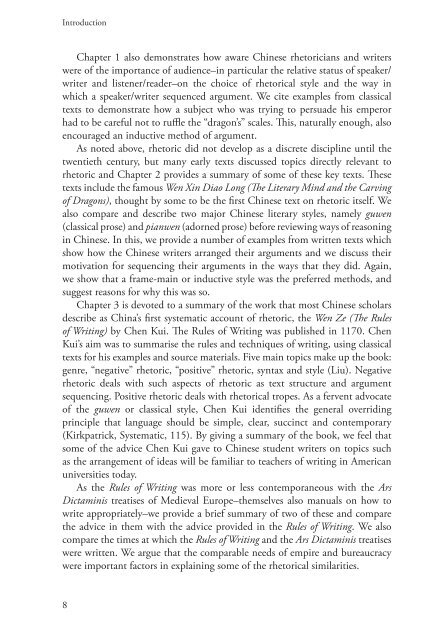Chinese Rhetoric and Writing - An Introduction for Language Teachers, 2012a
Chinese Rhetoric and Writing - An Introduction for Language Teachers, 2012a
Chinese Rhetoric and Writing - An Introduction for Language Teachers, 2012a
You also want an ePaper? Increase the reach of your titles
YUMPU automatically turns print PDFs into web optimized ePapers that Google loves.
<strong>Introduction</strong><br />
Chapter 1 also demonstrates how aware <strong>Chinese</strong> rhetoricians <strong>and</strong> writers<br />
were of the importance of audience–in particular the relative status of speaker/<br />
writer <strong>and</strong> listener/reader–on the choice of rhetorical style <strong>and</strong> the way in<br />
which a speaker/writer sequenced argument. We cite examples from classical<br />
texts to demonstrate how a subject who was trying to persuade his emperor<br />
had to be careful not to ruffle the “dragon’s” scales. This, naturally enough, also<br />
encouraged an inductive method of argument.<br />
As noted above, rhetoric did not develop as a discrete discipline until the<br />
twentieth century, but many early texts discussed topics directly relevant to<br />
rhetoric <strong>and</strong> Chapter 2 provides a summary of some of these key texts. These<br />
texts include the famous Wen Xin Diao Long (The Literary Mind <strong>and</strong> the Carving<br />
of Dragons), thought by some to be the first <strong>Chinese</strong> text on rhetoric itself. We<br />
also compare <strong>and</strong> describe two major <strong>Chinese</strong> literary styles, namely guwen<br />
(classical prose) <strong>and</strong> pianwen (adorned prose) be<strong>for</strong>e reviewing ways of reasoning<br />
in <strong>Chinese</strong>. In this, we provide a number of examples from written texts which<br />
show how the <strong>Chinese</strong> writers arranged their arguments <strong>and</strong> we discuss their<br />
motivation <strong>for</strong> sequencing their arguments in the ways that they did. Again,<br />
we show that a frame-main or inductive style was the preferred methods, <strong>and</strong><br />
suggest reasons <strong>for</strong> why this was so.<br />
Chapter 3 is devoted to a summary of the work that most <strong>Chinese</strong> scholars<br />
describe as China’s first systematic account of rhetoric, the Wen Ze (The Rules<br />
of <strong>Writing</strong>) by Chen Kui. The Rules of <strong>Writing</strong> was published in 1170. Chen<br />
Kui’s aim was to summarise the rules <strong>and</strong> techniques of writing, using classical<br />
texts <strong>for</strong> his examples <strong>and</strong> source materials. Five main topics make up the book:<br />
genre, “negative” rhetoric, “positive” rhetoric, syntax <strong>and</strong> style (Liu). Negative<br />
rhetoric deals with such aspects of rhetoric as text structure <strong>and</strong> argument<br />
sequencing. Positive rhetoric deals with rhetorical tropes. As a fervent advocate<br />
of the guwen or classical style, Chen Kui identifies the general overriding<br />
principle that language should be simple, clear, succinct <strong>and</strong> contemporary<br />
(Kirkpatrick, Systematic, 115). By giving a summary of the book, we feel that<br />
some of the advice Chen Kui gave to <strong>Chinese</strong> student writers on topics such<br />
as the arrangement of ideas will be familiar to teachers of writing in American<br />
universities today.<br />
As the Rules of <strong>Writing</strong> was more or less contemporaneous with the Ars<br />
Dictaminis treatises of Medieval Europe–themselves also manuals on how to<br />
write appropriately–we provide a brief summary of two of these <strong>and</strong> compare<br />
the advice in them with the advice provided in the Rules of <strong>Writing</strong>. We also<br />
compare the times at which the Rules of <strong>Writing</strong> <strong>and</strong> the Ars Dictaminis treatises<br />
were written. We argue that the comparable needs of empire <strong>and</strong> bureaucracy<br />
were important factors in explaining some of the rhetorical similarities.<br />
8


















